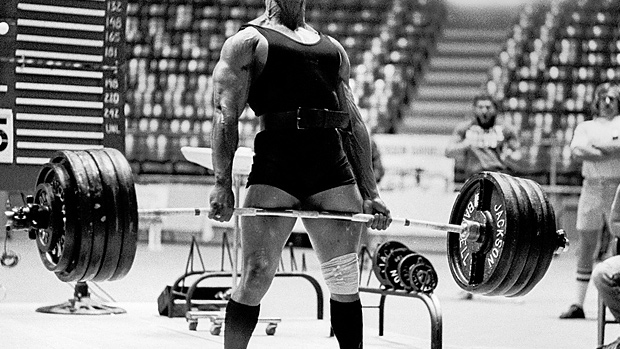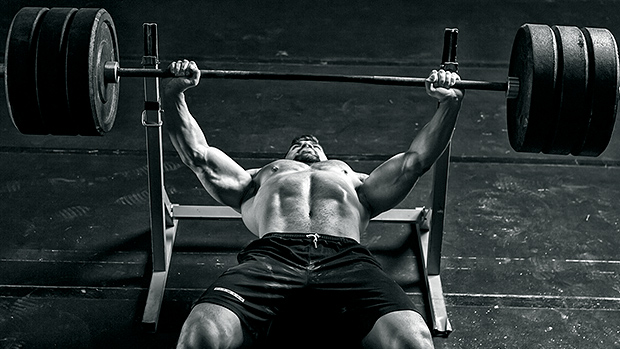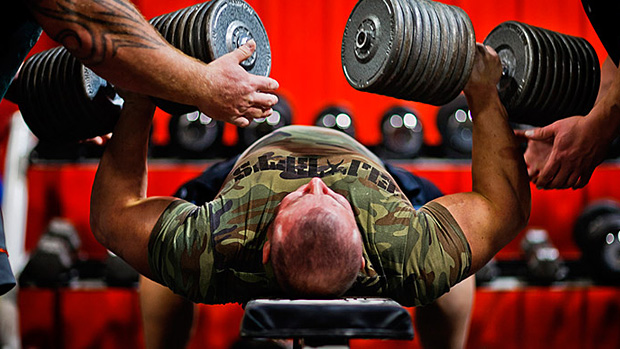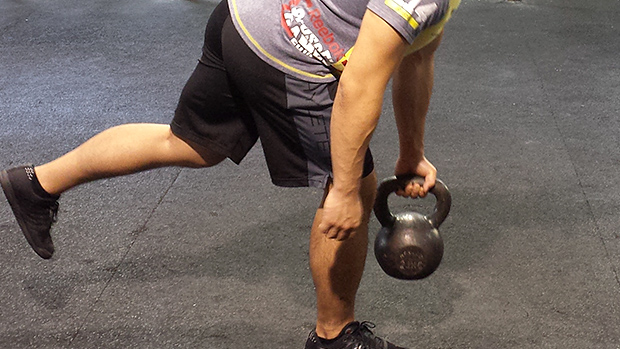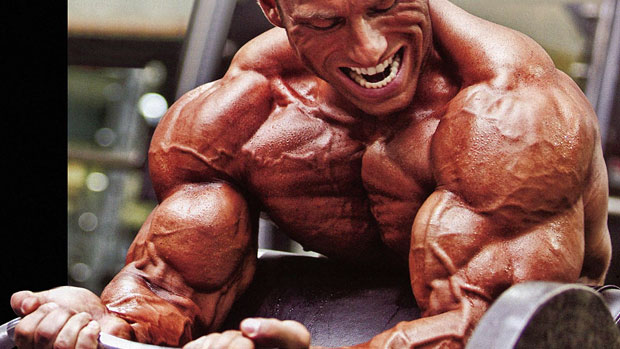T Nation: Jim, I'm a senior in high school and want to gain 20 pounds this summer in time for the upcoming football season. I don't have a ton of cash and don't have much in the way of cooking skills, either. Any suggestions? I really don't want to start counting calories and weighing my mom's meatloaf.
I feel your pain. I also struggled to gain weight in high school and have gone through many of the same challenges most of you skinny guys have or will go through, and then some.
I was able to pack on some pretty good weight in high school with a very simple system. Keep in mind I didn't count calories or macronutrients or weigh anything, nor do I think you need to either.
By the time I was a sophomore in high school, I had been lifting for about three years and was in desperate need of weight gain. At this point I was a three-sport athlete (football, basketball, run/throw in track) and never really had any breaks from running or an off-season to gain weight.
Supplements were still foreign to me but I persuaded my dad to buy me some weight gain powder (I don't remember what it was, but it added about 1500-1750 calories/day). I'd already been eating three times a day (breakfast, lunch, and dinner), so my plan was to eat as I normally would and drink three weight gain shakes AFTER each meal. I mixed each drink with two cups of milk. So a daily meal schedule would look like this:
- Breakfast: 3 eggs scrambled, toast, apple, juice + weight gain drink
- Lunch: 2 peanut butter and jelly sandwiches, banana + weight gain drink
- Dinner: Whatever my mom cooked + weight gain drink
The result? I gained 20lbs in a month, my lifts skyrocketed, and I didn't gain an inch on my waist. I don't know if my body was simply starving for nutrients but this worked wonders for me.
I managed to keep up this regimen for most of my high school career and felt great. Please understand that during this time I was lifting three times a week and running/jumping 4-7 days/week, and my main lifts were squat, bench, trap bar deadlift, and hang clean. In other words, I was expending a lot of energy that obviously justified the amount of calories I was taking in.
If you don't like weight gain powders or find all the sugar makes your farts smell like the kill-floor of a meat packing plant, you can always make your own "weight gainer" out of Metabolic Drive® Protein blended with whole milk or juice, some nuts, and a tablespoon or two of natural peanut butter or some other healthy fat. Add some Red Man and blend to taste.
T Nation: Jim, I read somewhere that you lost a ton of weight in college because your thyroid was messed up. Is that an urban legend or fact? How did you get the weight back on?
That's actually true. In my second year at the University of Arizona, I was diagnosed with Graves' disease. This means that I had a very overactive thyroid, and probably had it (after learning the symptoms) since high school; likely explaining the weight gaining issues that I addressed in the first question.
That second year I'd gone from 200lbs to a dismal 165. My strength dropped and I was an absolute wreck. It was so bad that I even weighed in for my football physical with weight plates hidden around my waist, if you can believe it.
I eventually managed to gorge myself up to 170 but it still wasn't good. I was embarrassed and had absolutely no idea what to do. Fortunately, our team doctor was able to diagnose it immediately and began treatments in September, and by November I'd shot up to 240lbs and was completely unrecognizable to anyone, including my sister. She picked me up at the airport gate (back before 9/11) and walked right by me.
Granted, much of the weight gain was because of the medication but food was still a big catalyst. I never had a real meal plan (I was in college so my schedule varied quite a bit), but I made goals of what I had to eat each day. Here were my goals:
- 2 pounds of ground beef
- 2 cups (uncooked) of rice
- 3 protein drinks with milk (during waking hours)
- 1 protein drink with milk (woke up in the middle of the night)
Not surprisingly, my strength went through the roof, but so did my waist line. That was a lot of weight to gain in such a short period of time, but understand that being big and strong was always my lifelong goal and I finally had a chance to do it.
If you want to gain weight, making it a primary goal is the most important thing. It was for me.
T Nation: Jim, I saw your pic in the 5/3/1 Manual and you look leaner than a Versace model on the CCC (coffee-cigarettes-cocaine) meal plan, at least compared to your powerlifting competition pics. How'd you lose all that tonnage?
What is this, the nutrition issue? Do I look like a fucking dietitian?
Here's some easy advice that will slice fat off of the laziest bastard, and you don't need a freaking food scale to do it.
Let me take you back–again--to my college weight gaining days. I eventually got up to around 255lbs. I was strong as hell, but couldn't run; not a very good combination for football. I had shin splints and a perpetual lower back pump that killed me, so I knew I had to drop the weight and get back into fighting shape.
As you can well imagine, my fat loss plan was also very basic. Lifting would continue as normal, and as I had to get my lungs back, I began doing 40-yard sprints, running stadiums, and doing some long distance work (as much as my shins would allow me). This was a slow process, but I knew all the roadwork was a necessity as I had to get my ass into shape for spring ball.
As for diet, I knew I had to cut back on my calories so I developed a very simple eating plan. Ready? I basically did the opposite of my high school weight gain system; so instead of drinking a weight gain shake after each meal, I drank a protein drink (2 scoops of whey protein in water) before I ate a meal.
What this did was fill me up before I ate and severely limited my food intake. I didn't really limit myself to what I ate, although I did try to eat cleaner.
So that's it: One protein drink (two scoops of protein) in water before every meal. The result? I got down to 235 quickly and eventually down to 225. This is by far the easiest way to lose weight without all the calorie counting and macronutrient-restricting stuff I've done in the past.
T Nation: My neck is so skinny, I look like Screech from Saved by The Bell after a four-week pomegranate juice fast. Help me out Jim. I'm sick of using shoelaces for neckties.
Ahhh, neck training. My obsession with building a big, thick neck started early in life, when I felt like I had a stack of dimes supporting this massive head of mine. Of course, like any young boy obsessed with strength, muscles, and being Conan the Barbarian, I didn't know the phrase "patience is a virtue."
I wanted a neck with thick cables on each side, one that would impress any red-blooded woman out of her (hopefully crotch-less) panties. And I wanted it NOW! (Only later in life would I learn that it's not the size of the neck but the size of the wallet that most women care about.)
The best way to develop a strong, thick neck is to play or participate in a sport like football, wrestling, rugby, or MMA. But since most of us are either past our prime (if we had any) or not interested, here are two of the best exercises to develop a neck.
Since most of you likely don't have access to a 4-way neck machine, the two exercises I recommend most are neck extension and neck flexion. Extension can be done with a simple neck harness, so get one. They may look like a mail-order item from an online S&M shop but they're cheap and actually work.
Flexion can be done while lying on a bench, head off of the bench, and a plate resting on a folded towel or T-shirt placed on your forehead. Imagine you're 69'ing your favorite UFC ring girl in a zero gravity environment and let your head bend back slowly and raise it back until your chin is touching your chest.
I recommend doing 50-100 reps of each, every workout. Do this for two years, four times a week. Mercifully, your collection of turtleneck sweaters will be a thing of the past.
There really isn't much to it and it's not terribly fancy. But it will be worth it.
T Nation: I just reached the 40-years-old milestone. Have you got any tips for your fellow lifters who have more grey pubes then they'd care to admit?
For the record, I don't possess any grey pubes. I've looked quite hard too. Actually that sounded even worse than I thought. Moving on...
I'm not that old but my body has been through a lot and I've really had to rethink training the last year. I'm not 18 anymore, but I'll be damned if I'm not going to keep kicking ass; I just have to be a little smarter about how I kick that ass.
Here are a few things I've done to keep myself healthy and feeling good, and still able to make progress on my bigger lifts.

Warm up (Using a PVC pipe, band, and lacrosse ball)
The first thing I do before every workout is roll out my IT bands, groin, hips, upper and lower back using a PVC pipe. I also use a lacrosse ball on my piriformis. After that, I static stretch my hip flexors and hamstrings using an average band. This really only takes about 10-15 minutes and I highly recommend people do this at least 1-3 times a day. It will make a massive difference.
So, a typical warm up would be:
- PVC pipe work
- Lacrosse Ball
- Band Stretching
After that, I also like to do some med ball slams, med ball throws, Prowler pushes, jumps, or bodyweight exercises to get my body ready for training. This is not a workout, but more of a primer; so treat it as such.
Bodyweight assistance work
This is another thing I've done quite a bit of. I always start my workouts with a big exercise (squat, clean, deadlift, press, bench) and very often follow it up with simple bodyweight exercises such as dips, chins/pull-ups, pushups, glute-ham raises, back raises, various ab exercises, and one leg squatting.
This allows me to get some extra work in but not load my spine or my body too much. So if you're feeling excessively sore or your joints are hurting, this might be a good option.

"Old Man" assistance work (using machines only)
This might be one of the better options for hypertrophy and strength among lifters who still want to make good progress on their bigger lifts but want to save their body. This is very similar to the bodyweight assistance work listed above: do the main lift/lifts of the day and hit the machines to train your assistance work.
First, it's going to be easier; man made machines to do his work for him. Second, you don't get caught up in what you're lifting when you're using a machine (well, at least you're less likely). Finally, you're able to get some good hypertrophy work in your workout.
Dan John mentioned in one of his latest articles that hypertrophy training was very important for an older lifter; the trick is to be smart enough about it so you can keep your strength up without completely burning out. My suggestion? Treat hypertrophy work like Viagra: pump up your muscles and have a good time. Use this time to do some of the stuff you used to do when you were a young kid and first discovered training.
As long as you make sure you are training your first lift hard and smart, you'll always be on the right track.
T Nation: I've read that really smart powerlifters can tell as soon as they're under an empty bar if they're going to hit a PR that day, while others need to get right to the peak set to know how well they'll perform. How can your average guy tell if a workout is going to kick ass or suck balls? And if the latter, should he just kill the workout or have an "easy" day?
I'm not sure if that first part is true, but I understand the question: do you train when you know you're going to suck? Do you go home? Or do you push through it?
99% of people will try to push through it and that's fine. BUT, you have to know how to push through it. When I'm feeling run down, I always make a deal with myself before I get in the weight room.
For example, let's say I have the following workout planned:
Standing Press 195x5, 220x3, 245x1+
Chins/Pull-ups 10 sets of 8
Standing Log Press 5 sets of 10 reps
Prowler Pushes 10 x 40-yard sprints, 1-minute rest
Nice plan; too bad I slept like crap, my dog shit in my bed, I found out that I have a STD, I had to ride a bagger to work, and everyone at work is on their period.
By the time I get to the weight room I feel awful, and I know my mind and body aren't going to perform optimally. So I simply make a goal of getting through the first exercise only. No extra reps on the last set; just do a warm-up, hit the work sets, and I'm free to go.
What this does is allow me to focus on ONE thing in the workout and not feel overwhelmed that I have to do everything else. Sure, I'm tired, but even a pussy can get through one exercise, right?
More often than not, I easily get through the first exercise and start making more deals/more goals. "Just one big set of chin-ups" or "I'll do a few Prowler trips and see how I feel." Stuff like that. Or, I just go home. The point is this: you have to recognize when you're feeling down and out and accept it. Once you do that, you can confront it with a plan.
The most important thing is this: you have to have a program that allows you to have a bad day and still progress while (at the same time) allows you to have a GREAT day when you're feeling strong.
If your program is missing this, find a new one. I see a million programs that have no planned progression and no room for good/bad days. That's Programming 100 (not even 101--you don't even get course credit, Corky).

